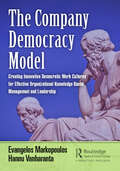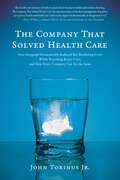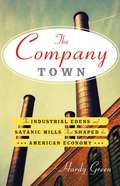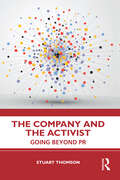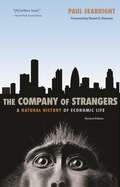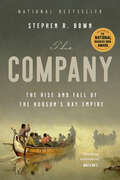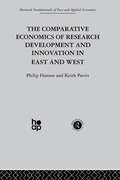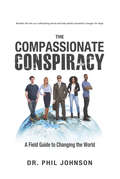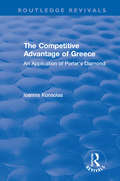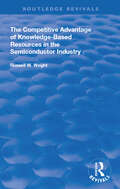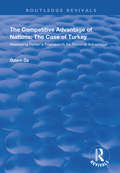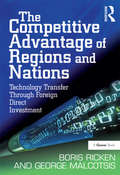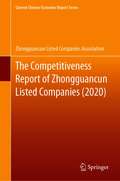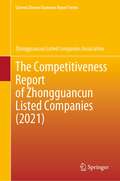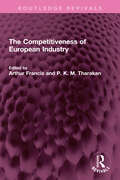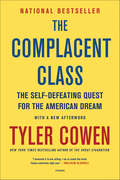- Table View
- List View
The Company Democracy Model: Creating Innovative Democratic Work Cultures for Effective Organizational Knowledge-Based Management and Leadership (Engineering Management)
by Evangelos Markopoulos Hannu VanharantaCompany democracy is often misunderstood in the business context as democracy is usually related to politics. In this book, the authors present a different dimension. They focus first on democracy from an organizational culture perspective and then offer employees opportunities to understand and apply democracy from the company floor level. The Company Democracy Model (CDM) is an industry-wide, practical methodology for knowledge management utilization under applied philosophical thinking. The model progresses through a framework in which an organizational evolutionary spiral method empowers the creation of knowledge-based democratic cultures for wise and effective strategic management and leadership. This new innovative methodology, supported with techniques and processes, can gain/create many ideas, insights, innovations, new products, and services that can benefit a company. One purpose of using the model is to create a robust conceptual framework as a theoretical basis for a business strategy that promotes sustainable, continuous, and democratic development. Another purpose is to emphasize the importance of intellectual capital and compare capital-related and human-related business issues in shaping a company’s competitiveness, profitability, productivity, performance, and shared value. A third purpose is to use its symbolic infrastructure that builds solid democratic systems for viable business development and management. Finally, the described purposes give the reader new ideas to change and improve the design of business activities in a collective and modern democratic way.
The Company I Keep: My Life in Beauty
by Leonard A. LauderIn his much-anticipated memoir, The Company I Keep: My Life in Beauty, Chairman Emeritus and former CEO of The Estée Lauder Companies Leonard A. Lauder shares the business and life lessons he learned as well as the adventures he had while helping transform the mom-and-pop business his mother founded in 1946 in the family kitchen into the beloved brand and ultimately into the iconic global prestige beauty company it is today.In its infancy in the 1940s and 50s, the company comprised a handful of products, sold under a single brand in just a few prestigious department stores across the United States. Today, The Estée Lauder Companies constitutes one of the world’s leading manufacturers and marketers of prestige skin care, makeup, fragrance and hair care products. It comprises more than 25 brands, whose products are sold in over 150 countries and territories. This growth and success was led by Leonard A. Lauder, Estée Lauder’s oldest son, who envisioned and effected this expansion during a remarkable 60-year tenure, including leading the company as CEO and Chairman.In this captivating personal account complete with great stories as only he can tell them, Mr. Lauder, now known as The Estée Lauder Companies’ “Chief Teaching Officer,” reflects on his childhood, growing up during the Great Depression, the vibrant decades of the post-World War II boom, and his work growing the company into the beauty powerhouse it is today. Mr. Lauder pays loving tribute to his mother Estée Lauder, its eponymous founder, and to the employees of the company, both past and present, while sharing inside stories about the company, including tales of cutthroat rivalry with Charles Revson of Revlon and others. The book offers keen insights on honing ambition, leveraging success, learning from mistakes, and growing an international company in an age of economic turbulence, uncertainty, and fierce competition.
The Company States Keep
by Aptara. Inc Julia GrayThis book argues that investor risk in emerging markets hinges on the company a country keeps. When a country signs on to an economic agreement with states that are widely known to be stable, it looks less risky. Conversely, when a country joins a group with more unstable members, it looks more risky. Investors use the company a country keeps as a heuristic in evaluating that country's willingness to honor its sovereign debt obligations. This has important implications for the study of international cooperation as well as of sovereign risk and credibility at the domestic level.
The Company That Solved Health Care: How Serigraph Dramatically Reduced Skyrocketing Costs While Providing Better Care, and How Every Company Can Do the Same
by John TorinusEven with new health-care policies, one thing is clear: health-care costs will continue to rise dramatically. While individuals may get better coverage, businesses will have the same problem they've had for the last four decades. Health care, one of corporate America's largest expenses, is growing at double-digit rates, and nothing done in Washington will change that. But one medium-size company set out to tame the beast of rising health-care costs, employing best practices and cutting-edge ideas. The results have caused others to sit up and take notice. Serigraph, Inc., a Wisconsin-based manufacturer of decorative parts, and its chairman, John Torinus, did what Washington can't or won't do: reduce cost increases to less than 2 percent while improving the quality of health care for its employees. The implications for corporate America are staggering--the opportunity for genuine reform in an expense category that has been spiraling out of control. Serigraph began its initiative to control health-care costs in 2003, when its annual health-care bill was $5 million and another $750,000 was needed for the projected 15 percent annual increase. The company employed three strategies for reform, each of which can cut the health-care bill by 20 percent to 40 percent--consumer responsibility, the primacy of primary over specialty care and centers of value. Applied in concert with other management methods, these three approaches almost eliminated growth in health-care costs while improving the quality of employee care. The results are documented. They are beyond refute. The Company That Solved Health Care describes the fascinating details of Serigraph's program, and shows how any company can achieve similar results. This book is essential reading for any manager responsible for his or her company's health-care expenses, any academic or thinker involved in the health-care debate and anyone who wants to better understand why health-care costs have been rising and what can be done to achieve price stability while improving patient care.
The Company Town: The Industrial Eden's and Satanic Mills That Shaped the American Economy
by Hardy GreenThis is a historical survey of the American experience with the company town. Green (a former editor at BusinessWeek) offers accounts of the origins and development of different company towns, distinguishing between "Exploitationvilles" in which companies sought to extract as much profit as possible from their workers, at one end of the spectrum, and more benign, even utopian, experiments that provided paternalistic support for workers' needs at the other. He describes the impact of these company towns on the nature of American capitalism, the range of living and working conditions experienced by workers in the towns, the labor disputes that frequently arose, and modern incarnations of the company town in the era of the information revolution. Annotation ©2011 Book News, Inc. , Portland, OR (booknews. com)
The Company and the Activist: Going Beyond PR
by Stuart ThomsonAddressing the rise of a new breed of activists who present a real threat not only to reputations but to business operations, this book explores what businesses need to understand about these communities, why they should be taken seriously, and how business leaders can successfully navigate this shifting terrain.Existing business books address only the communications challenges involved in the rise of these new communities, but this book goes beyond PR issues to the very real impact on business decisions – and acknowledges that businesses must understand activists, and vice versa, if progress is to be made. To lead this conversation, the book includes interviews and contributions from key players across activism and businesses to look at how both sides operate and what success looks like for them. It also features practical steps that businesses can take to build a network of supporters, drawing on global examples from the corporate sector, grassroots campaigns, and people and organisations taking up the mantle of activism.Leaders and professionals working in all aspects of business, across industries and firm types, will appreciate learning about what drives activists and how businesses can work with them to not only avoid reputational damage, but to create stronger connections and, perhaps, a better world.
The Company of Strangers: A Natural History of Economic Life - Revised Edition
by Paul SeabrightThe Company of Strangers shows us the remarkable strangeness, and fragility, of our everyday lives. This completely revised and updated edition includes a new chapter analyzing how the rise and fall of social trust explain the unsustainable boom in the global economy over the past decade and the financial crisis that succeeded it. Drawing on insights from biology, anthropology, history, psychology, and literature, Paul Seabright explores how our evolved ability of abstract reasoning has allowed institutions like money, markets, cities, and the banking system to provide the foundations of social trust that we need in our everyday lives. Even the simple acts of buying food and clothing depend on an astonishing web of interaction that spans the globe. How did humans develop the ability to trust total strangers with providing our most basic needs?
The Company of the Future: Maintaining the Health of a Living Company
by Arie De GeusThis chapter discusses why, in the shrinking world, companies conceived of as purely economic risk becoming an endangered species, while living companies have the opportunity to thrive.
The Company: The Rise and Fall of the Hudson's Bay Empire
by Stephen BownA thrilling new telling of the story of modern Canada's origins.The story of the Hudson's Bay Company, dramatic and adventurous and complex, is the story of modern Canada's creation. And yet it hasn't been told in a book for over thirty years, and never in such depth and vivid detail as in Stephen R. Bown's exciting new telling. The Company started out small in 1670, trading practical manufactured goods for furs with the Indigenous inhabitants of inland subarctic Canada. Controlled by a handful of English aristocrats, it expanded into a powerful political force that ruled the lives of many thousands of people--from the lowlands south and west of Hudson Bay, to the tundra, the great plains, the Rocky Mountains and the Pacific northwest. It transformed the culture and economy of many Indigenous groups and ended up as the most important political and economic force in northern and western North America.When the Company was faced with competition from French traders in the 1780s, the result was a bloody corporate battle, the coming of Governor George Simpson--one of the greatest villains in Canadian history--and the Company assuming political control and ruthless dominance. By the time its monopoly was rescinded after two hundred years, the Hudson's Bay Company had reworked the entire northern North American world.Stephen R. Bown has a scholar's profound knowledge and understanding of the Company's history, but wears his learning lightly in a narrative as compelling, and rich in well-drawn characters, as a page-turning novel.
The Comparative Economics of Research Development and Innovation in East and West (Harwood Fundamentals Of Pure And Applied Economics Ser.)
by Professor Philip Hanson P. Hanson K. PavittA systematic comparison of the institutions and incentive systems governing the processes of technological invention, innovation and diffusion in advanced market and centrally planned economies.
The Compassion Fatigue Workbook: Creative Tools for Transforming Compassion Fatigue and Vicarious Traumatization (Psychosocial Stress Series)
by Françoise MathieuThe Compassion Fatigue Workbook is a lifeline for any helping professional facing the physical and emotional exhaustion that can shadow work in the helping professions. Since 2001 the activities in this Workbook have helped thousands of helpers in the fields of healthcare, community mental health, correctional services, education, and the military. In addition to a comprehensive description of compassion fatigue and vicarious traumatization, The Compassion Fatigue Workbook leads the reader through experiential activities designed to target specific areas in their personal and professional lives. It provides concrete strategies to help the reader develop a personalized plan for identifying and transforming compassion fatigue and vicarious traumatization. Topics covered include: understanding compassion fatigue and vicarious trauma symptom checklist targeting areas for strategic planning understanding warning signs assessing contributing factors evaluating self-care identifying triggers solutions: personal, professional and organizational strategies.
The Compassionate Achiever: How Helping Others Fuels Success
by Christopher L. KukkA powerful, practical guide for cultivating compassion—the scientifically proven foundation for personal achievement and success at work, at home, and in the community.For decades, we’ve been told the key to prosperity is to look out for number one. But recent science shows that to achieve durable success, we need to be more than just achievers; we need to be compassionate achievers.New research in biology, neuroscience, and economics have found that compassion—recognizing a problem or caring about another’s pain and making a commitment to help—not only improves others’ lives; it can transform our own. Based on the most recent studies from a wide range of fields, The Compassionate Achiever reveals the profound benefits of practicing compassion including more constructive relationships, improved intelligence, and increased resiliency. To help us achieve these benefits, Christopher L. Kukk, the founding Director of the Center for Compassion, Creativity and Innovation, shares his unique 4-step program for cultivating compassion. Kukk makes clear that practicing compassion isn’t about being a martyr or a paragon of virtue; it’s about rejecting rage and indifference and choosing instead to be a thoughtful, caring problem-solver. He identifies the skills every compassionate achiever should master—listening, understanding, connecting, and acting—and outlines how to develop each, with clear explanations, easy-to-implement strategies, actionable exercises, and real-world examples. With the The Compassionate Achiever everyone wins—we can each achieve success in our own lives and create more productive workplaces, and healthier, less violent communities.
The Compassionate Conspiracy: A Field Guide to Changing the World
by Philip JohnsonAs the world around us gasps for breath in an environment of unprecedented complexity and need, we find ourselves overwhelmed and asking is there anything we can do to make a difference? The Compassionate Conspiracy answers with a resounding Yes and serves as a practical guide to help readers discover their passion and develop their personal plan to make a world of difference.
The Compensation Committee Handbook
by James F. Reda Stewart Reifler Michael L. StevensNew and updated information on the laws and regulations affecting executive compensationNow in a thoroughly updated Fourth Edition, The Compensation Committee Handbookprovides a comprehensive review of the complex issues challenging compensation committees that facerevised executive compensation disclosure regulations issued by the SEC, as well as GAAP andIFRS rulings and trends. This new and updated edition addresses a full range of functionalissues facing compensation committees, including organizing, planning, and best practicestips.Looks at the latest regulations impacting executive compensation, including new regulationsissued by the SEC, as well as GAAP and IFRS rulings and trendsCovers the selection and training of compensation committee membersExplores how to make compensation committees a performance driver for a companyGuides documentation requirements and timing issuesThe Compensation Committee Handbook, Fourth Edition will help all compensationcommittee members and interested professionals succeed in melding highly complex technical informationand concepts with both corporate governance principles and sound business judgment.
The Competitive Advantage of Emerging Market Multinationals
by Afonso Fleury Maria Tereza Leme Fleury Peter J. Williamson Ravi RamamurtiMultinationals from Brazil, Russia, India and China, known as the BRIC countries, are a new and powerful force in global competition and are challenging the incumbency of much older global companies from the developed world. Emerging market multinational enterprises (EMNEs) now account for a quarter of foreign investment in the world, are a prolific source of innovation and make almost one in three cross-border acquisitions globally. Despite this, traditional theories of international business do not provide a satisfactory explanation of their behaviour or performance. The authors of this book shine new light on the rise of the EMNEs and how they have built a competitive advantage through innovation, novel configurations of their international value chains and the acquisition of companies overseas. Any manager, policy maker or researcher who wishes to understand the emergence of this new breed of multinational will find this book an invaluable resource.
The Competitive Advantage of Greece: An Application of Porter's Diamond (Routledge Revivals)
by Ioannis KonsolasThis title was first published in 2002: This compelling text is the first major application of Michael Porter's diamond framework to identify the sources of national competitive advantage in the case of Greece. Offering a useful evaluation of Porter's theory through an extensive literature review, the book also draws on empirical evidence from five selected Greek industries. It also provides information and commentary on many aspects of the Greek economy, its historical evolution and its current trends. International and Greek investors, international organizations, business consultants and financial institutions will certainly benefit from this analysis of the Greek economic environment. Moreover, universities and researchers will be interested in the evidence supporting or refuting parts of the widely used and cited "diamond" framework.
The Competitive Advantage of Knowledge-Based Resources in the Semiconductor Industry
by Russell W. WrightFirst Published in 1997. Knowledge and knowledge-based resources occupy critical positions in a company’s value chain. The theme of the book is that organizational distinctive competences are asymmetrical accumulations of knowledge-based resources relative to a firm's competitors. These accumulations of knowledge and capabilities enable and constrain a firm's ability to develop competences in specific areas such as new product development. Knowledge and capabilities are sources of competitive advantage to the extent that they are non-transferable and non-imitable The imitability of knowledge-based resources is a function of two conceptually distinct attributes: tacitness and tangibility. This book looks at how the evolution of industry knowledge influences new product strategies in successive product generations of the semiconductor industry. This book also makes some basic distinctions among the types of organizational resources that tend to generate unusual economic returns.
The Competitive Advantage of Nations: Assessing Porter's Framework for National Advantage (Routledge Revivals)
by Özlem ÖzFirst published in 1999, this volume applies Professor Michael Porter’s diamond framework (1990) to the Turkish glass, construction, leather clothes, automobile and flat steel industries. Özlam Öz aims primarily to contribute towards an improvement of this framework, and thus towards a better understanding of the sources of competitive advantage. Her research presents a new approach to evaluate the competitiveness of the Turkish economy, given that alternative studies usually focus on factors like exchange rates and the cost of labour and raw materials as the determinants of competitive advantage. The author begins her book by providing an evaluation of the diamond framework linked to the debate created by the publication of The Competitive Advantage of Nations. She then identifies the pattern of advantage in Turkey by specifying the internationally competitive industries and clusters. This is followed by a detailed examination of the five Turkish industry case studies - glass, construction, leather clothes, automobile and flat steel industries. The findings are generally supportive of Porter. The results suggest, however, several major areas in the framework - especially domestic rivalry and the role of government - where one or more of the Turkish cases question Porter's hypothesises. The book ends with the implications of the study for the sources of competitive advantage in general and for the Turkish economy in particular. Porter and his diamond framework are both unquestionably influential. Improvements upon it forwarded in this book will be of use to academic readers as well as strategic planners and policy makers.
The Competitive Advantage of Regions and Nations: Technology Transfer Through Foreign Direct Investment
by Boris Ricken George MalcotsisThe importance of technology transfer for the competitive advantage of companies and the economic success of nations cannot be overstated. Technology is a determining element for firms and nations to increase productivity, to compete, and to prosper. In The Competitive Advantage of Regions and Nations, the authors stress that companies, investment promotion agencies, and government bodies cannot simply sit and wait until new technologies arrive in their domain. Rather, they need to manage the identification, assessment, attraction, absorption and application of new technologies. In this comprehensive book, Boris Ricken and George Malcotsis explain how technology transfer in Foreign Direct Investment (FDI) projects can be systematically managed. Using some 40 case studies as illustration, they give step-by-step guidance for managers. The explanation of theory in this book, together with the frameworks and cases delivering solutions to the various challenges of technology transfer will be highly appreciated by managers of companies, investment promotion agencies, and government bodies alike. It also offers students confronted with the topic an understandable study guide.
The Competitiveness Report of Zhongguancun Listed Companies (2018)
by Zhongguancun ListedThis book addresses the fundamental development status and provides the systematic analysis of Zhongguancun Listed Companies, from different perspectives of financial statistics, comparisons among different regions and company structures. Zhongguancun, the origin and the representative of Chinese modern innovation, has collected over 300 Listed Companies so far. The book also offers an illustration that how Zhongguancun Listed Companies developed in 2017, including the market performance, the profitability, the debt paying capacity, the conditions of operating, innovation, investing and dominant industries, with the proposal of the existing difficulties and developing suggestions in depth. The book aims at objectively presenting the competitiveness characteristics and development status of Zhongguancun Listed Companies. Whether you're a global investor, an economic researcher, or ordinary people, this book will be an important way to understand China's scientific and technological innovation achievements and Zhongguancun outstanding enterprises.
The Competitiveness Report of Zhongguancun Listed Companies (2019)
by Zhongguancun Listed Companies AssociationThis book is based on the comprehensive grasp and analysis of the financial data of ZLCs and In-depth observations by ZLCA for many years. This book will objectively present the capital market distribution, overall scale, profitability, innovation ability and social contribution of ZLCs from multiple dimensions, and carry out thematic analysis and research on the high proportion of accounts receivable to current assets in ZLCs in recent years, aiming at objectively presenting their competitive strength and development status. Whether you are an investor, an economic researcher or the general public interested in Z-Park, this book will be an important way for you to understand the latest development of Z-Park and the high-quality listed companies in Z-Park.
The Competitiveness Report of Zhongguancun Listed Companies (Current Chinese Economic Report Series)
by Zhongguancun Listed Companies AssociationThis book focuses on the comprehensive grasp and analysis of the financial data of ZLCs in 2020 and in-depth observations by ZLCA for many years. This book objectively presents the capital market distribution, overall scale, profitability, innovation ability and social contribution of ZLCs from multiple dimensions and carries out thematic analysis and research on the high proportion of accounts receivable to current assets in ZLCs in recent years, aiming at objectively presenting their competitive strength and development status. Whether you are an investor, an economic researcher or the general public interested in Z-Park, this book is an important way for you to understand the latest development of Z-Park and the high-quality listed companies in Z-Park.
The Competitiveness Report of Zhongguancun Listed Companies (Current Chinese Economic Report Series)
by Zhongguancun Listed Companies AssociationThis book is based on the comprehensive grasp and analysis of the financial data of Zhongguancun listed companies (ZLCs), and in-depth observations by ZLCA for many years. This book presents the capital market distribution, overall scale, profitability, innovation ability and social contribution of ZLCs in multiple dimensions, and carris out thematic analysis and research of the high proportion of accounts receivable to current assets in ZLCs in recent years, aiming at objectively presenting their competitive strength and development. Whether investors, researchers or reporters who are interested in Z-Park, this book is an important reference to better understand the latest development of Z-Park and the high-quality listed companies in Z-Park.
The Competitiveness of European Industry (Routledge Revivals)
by Arthur Francis P. K. M. TharakanFirst published in 1989, The Competitiveness of European Industry helps in developing our understanding of the process of improving and measuring industrial competitiveness. The contributors focus on the competitiveness of European industry. Three main topics are discussed: the concept of competitiveness itself; what can be learned about competitiveness at the level of an individual national economy; and processes and strategies in forms which might contribute to improved competitive performance. The first two papers critically assess concepts and measures of national competitiveness and review the performances of the economies of Britain, France, and the Federal German Republic. Then follow accounts of industrial competitiveness in three smaller economies (Belgium, Switzerland, and Sweden), which develop a series of methods and techniques for the analysis of industrial structures and indicate significant policy implications. The three concluding papers look at the competitiveness of British industry at the firm level, focusing on the strategic changes, the competitive process, and technical innovation. This book will be of interest to policy makers, business school teachers, and researchers in the area of strategy, industrial economics, organization behaviour, and innovation management.
The Complacent Class: The Self-Defeating Quest for the American Dream
by Tyler CowenA Wall Street Journal and Washington Post Bestseller"Tyler Cowen's blog, Marginal Revolution, is the first thing I read every morning. And his brilliant new book, The Complacent Class, has been on my nightstand after I devoured it in one sitting. I am at round-the-clock Cowen saturation right now."--Malcolm Gladwell Since Alexis de Tocqueville, restlessness has been accepted as a signature American trait. Our willingness to move, take risks, and adapt to change have produced a dynamic economy and a tradition of innovation from Ben Franklin to Steve Jobs.The problem, according to legendary blogger, economist and best selling author Tyler Cowen, is that Americans today have broken from this tradition—we’re working harder than ever to avoid change. We're moving residences less, marrying people more like ourselves and choosing our music and our mates based on algorithms that wall us off from anything that might be too new or too different. Match.com matches us in love. Spotify and Pandora match us in music. Facebook matches us to just about everything else.Of course, this “matching culture” brings tremendous positives: music we like, partners who make us happy, neighbors who want the same things. We’re more comfortable. But, according to Cowen, there are significant collateral downsides attending this comfort, among them heightened inequality and segregation and decreased incentives to innovate and create.The Complacent Class argues that this cannot go on forever. We are postponing change, due to our near-sightedness and extreme desire for comfort, but ultimately this will make change, when it comes, harder. The forces unleashed by the Great Stagnation will eventually lead to a major fiscal and budgetary crisis: impossibly expensive rentals for our most attractive cities, worsening of residential segregation, and a decline in our work ethic. The only way to avoid this difficult future is for Americans to force themselves out of their comfortable slumber—to embrace their restless tradition again.
